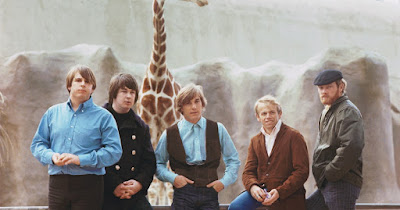Escrita por
Brian Wilson e Tony Asher, foi gravada em 11 e 25 de março de 1966,
no Sunset Sound Recorders e na CBS Columbia Square, em Hollywwod,
California. Foi lançada no disco Pet Sounds, em 16 de maio de 1966.
É a décima
canção do disco Pet Sounds. A letra é expressa na perspectiva de
um narrador que avisa ao ouvinte que ele vai ter um desilusão
amorosa com o novo amor que ele arranjou. Here today retrata um
pessimismo que precede um otimismo anterior. O fim do relacionamento.
É um dos arranjos mais ambiciosos de Brian Wilson e muitos acham que
é a melhor música do Pet Sounds.
Brian Wilson
diz que Here today foi um trabalho de arte. Os trombones deram um
toque masculino. A música foi inspirada em Bach, um músico barroco.
Mike Love
fez os vocais principais. O resto foi feito por músicos de estúdio.
Foi regravada por Bobby Vee, Brian Wilson, entre outros.
A letra:
It starts with
just a little glance now
Right away you're thinkin' 'bout romance now
You know you ought to take it slower
But you just can't wait to get to know her
A brand new love affair is such a beautiful thing
But if you're not careful think about the pain it can bring
It makes you feel so bad
It makes your heart feel sad
It makes your days go wrong
It makes your nights so long
You've got to keep in mind love is here today
And it's gone tomorrow
It's here and gone so fast
Right now you think that she's perfection
This time is really an exception
Well you know I hate to be a downer
But I'm the guy she left before you found her
Well I'm not saying you won't have a good love with her
But I keep on remembering things like they were
She made me feel so bad
She made my heart feel sad
She made my days go wrong
And made my nights so long
You've got to keep in mind love is here today
And it's gone tomorrow
It's here and gone so fast
Keep in mind love is here today
And it's gone tomorrow
It's here and gone so fast
Love is here today
And it's gone tomorrow
It's here and gone so fast
Right away you're thinkin' 'bout romance now
You know you ought to take it slower
But you just can't wait to get to know her
A brand new love affair is such a beautiful thing
But if you're not careful think about the pain it can bring
It makes you feel so bad
It makes your heart feel sad
It makes your days go wrong
It makes your nights so long
You've got to keep in mind love is here today
And it's gone tomorrow
It's here and gone so fast
Right now you think that she's perfection
This time is really an exception
Well you know I hate to be a downer
But I'm the guy she left before you found her
Well I'm not saying you won't have a good love with her
But I keep on remembering things like they were
She made me feel so bad
She made my heart feel sad
She made my days go wrong
And made my nights so long
You've got to keep in mind love is here today
And it's gone tomorrow
It's here and gone so fast
Keep in mind love is here today
And it's gone tomorrow
It's here and gone so fast
Love is here today
And it's gone tomorrow
It's here and gone so fast
A versão dos Beach Boys:
A versão de Bobby Vee:
A versão de Brian Wilson:


















